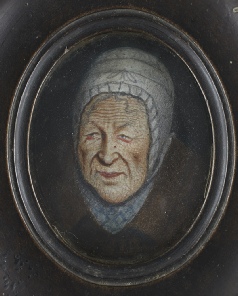





STOKE ST MARY AND DISTRICT HISTORY GROUP

ELIZABETH BROADMEAD
Elizabeth Broadmead’s fame lies in the fact that she is believed to have been one of the oldest living individuals in Somerset. Her exact date of birth is not known, but at her death her age was given as somewhere between 114 and 117 years of age.
Elizabeth Broadmead was born in the parish of Trull some time between 1666 and 1670.
She was the daughter of a little farmer who “bore arms at the battle of Sedgemoor, when the Duke of Monmouth’s army was defeated there in 1685”. At the time she was between 15 and 19 years, and had been left at home by her father to take care of the family and bring the produce of the farm to the camp or Taunton market. She is believed to have walked in the procession, though perhaps not as one of the “Fair Maids of Taunton”, before the Duke of Monmouth on his entry into Taunton on 18th June 1685. Even when she was very old she could still recount events within her own knowledge, at, and even before the time of Monmouth’s defeat.
She had obtained her support as a washer-
Oxford Journal -
She married a soldier, and still had his blue coat, as she was wearing it when a miniature was painted of her by P Foy on 23 March 1781. The miniature, 2 ins x 1 1/2 was painted for Dr Thomas Woodforde, the grandfather of Mary Woodforde of Stoke St Mary. Dr Woodforde was greatly interested in the old woman and believed her to be born in 1666.
In 1783, two years after the miniature was painted, Dr Woodforde took his son Charles [Mary’s father], then a lad, to see her. It is said that she smoked a pipe and spoke distinctly un-
The following is a description of her, extracted from the Bath Chronicle. It is to be found in “The History and Antiquities of the County of Somerset”, Volume 3 by the Rev. John Collinson.
“About four years since she became incapable of walking, and lost the use of her right arm, soon after this she lost her sight and became too deaf to hear and understand unless spoken to very near, and with a considerable exertion of voice. She is about middle stature and has strong features. Her nose has been large and projects considerably at the end, and her voice, though now reduced to a treble, has been strong, harsh and masculine.
Being blind, she did not perceive my entering the room and for a while I refrained from speaking that I might see her free from all restraint. It was her dinner time; and she was sitting by the fire with a small table before her, on which was an earthen pan with some cut pieces of boiled meat and bread in it. This she ate with an apparently good appetite feeding herself with her left hand. Though her teeth were gone, she chewed her food a little and swallowed it pretty quick. When she opened her lips to take a morsel I observed her tongue would frequently fall out and seemed very think, and too big for her mouth. Her complexion was rather dark, her eyes languid, but the line of feature were still strong; and I should not, from her countenance merely have supposed her more than 70, or at most 80 years old. She often complains of being in pain and wishes for death. She frequently groans but it appears to be more from habit than any other cause.
She has a daughter living with her, who is between 70 and 80 years of age. After some little conversation, the old woman sung us a stanza of a song made in her youth; but very justly observed as an apology for herself that her singing days were now over. Although in very indigent circumstances, she is decently supported with every necessary by Henry Whitmarsh, esquire (a gentleman who lives near her) and some other kind neighbours; and there appears no signs of a speedy dissolution.
One wonders whether that piece was actually written by Dr Woodforde himself.
She was buried in Wilton Parish churchyard on 10 March 1784.
Taunton Museum has the actual minature in its collection

Picture of Elizabeth Broadmead
[Kindly supplied by Taunton Museum where the minature is to be found]